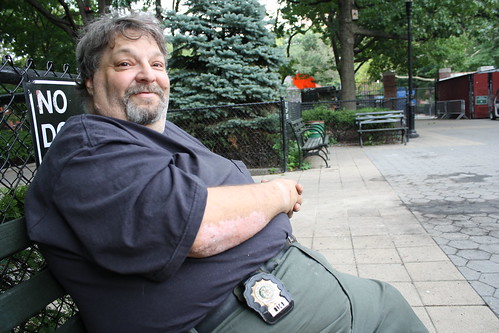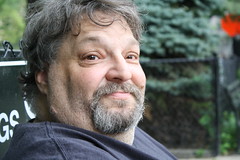 Timothy J. Stenovec Harry Greenberg retires today after 22 years as the supervisor of Tompkins Square Park.
Timothy J. Stenovec Harry Greenberg retires today after 22 years as the supervisor of Tompkins Square Park.Harry Greenberg remembers the moment Tompkins Square Park changed. It was the winter of 1992, and the Friends of Tompkins Square, a now defunct civic organization, planted a pine tree on the eastern side of the park’s central lawn. In the first of what has become an annual caroling celebration, community members adorned the tree with lights and decorations. If recent history were any indication, that tree and its ornaments should have been stripped down and hocked by the park’s homeless, the fate countless park plants had already suffered. But miraculously, the tree—and the decorations—remained, day after day.
“Nobody ripped the lights down, and that’s when you knew people enjoyed it,” Mr. Greenberg said.
Indeed, Tompkins Square Park today is a far cry from the park that Mr. Greenberg found when he arrived here as a fresh-faced parks supervisor in 1988. “I’d have to crawl over people that were sleeping out here with their dogs,” Mr. Greenberg said, describing what it was like to come into his office at five o’clock each morning.
Now, Mr. Greenberg drives his black Ford Escape from his home in Coney Island all the way up to the entry gate of his office, located on the north side of the park. But today Mr. Greenberg, the supervisor of Tompkins Square Park, will make that drive for the last time. After a 35-year career with the New York City Department of Parks and Recreation, the last 22 of which he spent at the East Village’s most famous park, Mr. Greenberg will hang up his Parks uniform.
Mr. Greenberg’s tenure at Tompkins Square Park has been marked by a radical transformation of the neighborhood’s signature public space. It went from a tent city of homeless people and drug addicts to a place where neighborhood children run barefoot through fountains on thick summer days. Yet park goers today remain a diverse group that includes young parents, the homeless, dog owners, skateboarders, punks and crusties, among others.
When people who have worked with Mr. Greenberg speak of him, they describe a leader whose strength was his ability to build a rapport with all of the park’s various constituencies, from the yuppies to the homeless, and everyone in between.
Marguerite Van Cook, a former director of the Howl! Festival, the annual Tompkins Square Park arts celebration, recalled approaching Mr. Greenberg with the concern that the four-day festival might displace some of the park’s homeless.
“Harry explained to me how the homeless people perceive themselves in relation to the different events that came into the park, and it allowed me to see them in a different light,” she said. “He was like a magical choreographer of personalities; he would move the different ethnic groups and the different social groups and the different cultural groups into different areas so that were all able to coexist harmoniously.”
 Timothy J. Stenovec A colleague describes Mr. Greenberg as “a magical choreographer of personalities.”
Timothy J. Stenovec A colleague describes Mr. Greenberg as “a magical choreographer of personalities.”Roland Legiardi-Laura, a 57-year-old poet and documentary filmmaker, sits on the board of directors of the East Village Parks Conservancy, a nonprofit group that works in partnership with the city to maintain the neighborhood’s parks, and has worked with Mr. Greenberg since the mid-90s.
He describes Mr. Greenberg as equal parts psychologist, diplomat, referee, listener and doer. “The park is a place for class warfare to play itself out on some level,” Mr. Legiardi-Laura said. “And I think Harry has managed to negotiate those difficult shoals and serve all those different people as best he could.”
Mr. Greenberg is 57 and it would not be a stretch if Central Casting called on him if it needed a Santa Claus. His goatee is mostly white, as is all the stubble on his face and neck. When he smiles, which is often, his eyebrows arch and his eyes light up.
Mr. Legiardi-Laura, the poet, could also be considered a de facto historian of Tompkins Square Park. While walking through the park in July, he recalled one of the stipulations made by the Stuyvesant family in 1829 when they donated the land that would one day become the park: the condition that the space always be used for the benefit of the public.
“Harry, I think in many ways has honored the broadest interpretation of that covenant,” he said.
This summer, as bikini-clad sunbathers soaked up rays, one last strand of gold tinsel remained at the top of the pine tree, a symbol of Mr. Greenberg’s service.
“In modern times,” Mr. Legiardi-Laura said, “Harry has been the person to usher in the park as a very well-used and multi-layered community space.”



